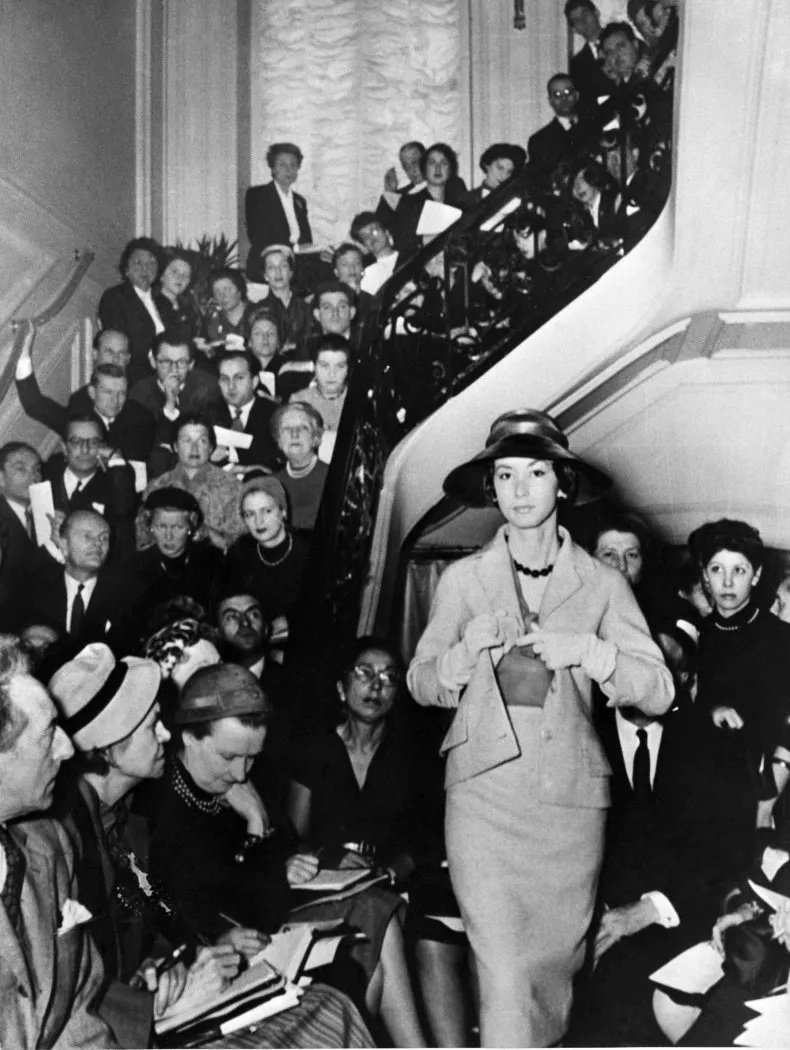A Surprisingly Modern Take on America From a Long-Dead Frenchman
Leah McGrath Goodman
Newsweek
January 21, 2015
During a trip to London earlier this month, I happened to pick up a copy of Christian Dior’s autobiography, Dior by Dior, recently reprinted by London’s Victoria and Albert Museum, and quickly found myself smitten with his spare but charming prose—not to mention more than a little surprised by the designer’s plainspoken comparisons of the U.S. and France.
At a moment when the economies of Europe and America are diverging once again, with America outpacing the rest of the world after emerging from a recession sparked by the financial crisis, I found illuminating Dior’s impressions of the New World in the late 1940s and ’50s, comparing European austerity with American exuberance.
Born 110 years ago this week in Normandy, Dior was one of the world’s greatest fashion designers. Unlike many of his French compatriots, he extolled throughout his life the virtues of the American dream and the U.S. economy—an environment both cutthroat and inviting, he said, which taught him the invaluable lessons of success.
Dior, who had never been to America in 1947 when he first launched the “New Look”—known for its long, billowy skirts, cinched waists and emphasis on high glamour in the wake of the dreary and androgynous trappings of World War II—soon found himself on a tour of the States amid sudden international fame and heavy demand for his ultra-feminine brand of haute couture.
Hailed for ushering in the golden age of couture by fashion luminaries like Carmel Snow of the American edition of Harper’s Bazaar, the New Look made Dior an overnight sensation and reestablished France as the undisputed epicenter of fashion—perhaps now just a small slice of history, but a reminder of how a fallen empire can be resurrected on the shoulders of a single man. Dior’s reinvigoration of the industry was no mean feat; France had lost many of its private clients during the war, and the Germans at one point threatened to move couture to Berlin. In America, Dior found inspiration and a way to rebuild the fortunes of French fashion.
“America is the land where every new enterprise, every original idea, encounters the warmest welcome and arouses the most lively interest,” he wrote in his autobiography. “Nowhere else can the gap between the project and its realization be bridged so straightforwardly.”
A neat little tome whose reflections still resonate, Dior by Dior marvels at the American attitude toward risk taking, which did not at all match the tightly conservative postwar attitudes of Europe. “The Americans know how to take a chance,” Dior said. “They offer you generously the whole armory of success. If things do not turn out right, it does not matter all that much; there is always another race to be run and there is absolutely no bitterness toward the horse that failed.”
America’s easy opportunism meant a lot to Dior, as a businessman born into an entrepreneurial and wealthy factory-owning family that lost its fortune well before he came into his. In 1949, sailing the Queen Elizabeth to New York and traveling from the East to West coasts, Dior was astonished by the American propensity for consumption, excess and its ease in abandoning old ideas for new.
“Like all Frenchmen, I had been struck by the amazing, stunning richness of the United States,” he said. “Wastage there seemed not only natural, but was actually recommended as an essential factor to the prosperity of the country. My upbringing made this a tremendous shock to me, but later the terrific creative energy of the Americans encouraged me toward further creative enterprises of my own.”
At first, Dior’s fashions were met with outrage in places like Britain, as his sumptuous dresses required many yards of the finest fabrics at a time when rationing hadn’t yet ended. This meant instead of openly viewing his debut collection, British royals, including Queen Elizabeth, went to see it in secret at London’s French Embassy.
Dior himself found the building of a fashion house in New York to be a process rife with unexpected calamity and wastage, from construction delays to nasty legal tangles. “When we reached New York, nothing was ready,” he said. “Contrary to the widely held notion, Americans are not really people in a hurry. On the contrary, they all seem on their honor to be late—particularly the contractors!”

AFP/GETTY
A model wears a Christian Dior creation at a fashion show in the Maison Dior, Paris, in 1956.
Before he opened his doors on Manhattan’s Fifth Avenue in 1949 (which has since shifted to East 57th Street), he was called before the American Anti-Trust Department for what he described as a terrifying examination over his insistence that clients sign a contract to not copy his designs. “The famous contract was annulled,” he recounted, “But this episode reinforced my conviction, in which all the serious American couturiers concur, that the pillaging of artistic creation is not only authorized in the United States, but encouraged.”
Dior would reign for only a decade—he died suddenly in 1957 from a heart attack at 52 while vacationing in Montecatini, Italy, after, depending on whom you believe, choking on a fish bone or, according to the memoirs of a Parisian friend, a sexual encounter. But within the first year of opening the Christian Dior-New York branch, his fashions accounted for an estimated 75 percent of Paris’s fashion exports and 5 percent of France’s annual export revenue.
What did he think of American women? There existed, he wrote in his autobiography, one “essential difference” between the women of the Old World and New World. “American women had all the shiny brilliance of a new penny. Their clothes were impeccable, their hair and their nails were impeccable. In short, the Americans were impeccable. It was true of all classes of society from the millionaires down to the liftman’s daughter.” The personality of the American woman, he summed up, is strong-minded and impulsive.
While impeccable was good, Dior lamented that Americans did give the impression of uniformity and a “regrettable lack of discernment.” The bold displays of color he saw in New York—for instance, from “the paintwork of the cars, continued on to the dresses of the passengers or the hideous ties of the drivers”—jarred him. “A certain taste for exaggeration nullifies the American elegance,” observed Dior, whose favorite colors tended toward gray and cream.
Of course, this was at the dawn of the 1950s. Dior noted that, in the decade to follow, America’s Old World counterparts would swiftly catch up to the new-penny quality of the ladies of the New World, and Americans would develop “the taste for subtle colors, the smartest of all tastes.”
American women, in fact, “are marvelously protected against errors of taste,” Dior said after visiting several of the nation’s cities. “Their shops offer them their pick of the world’s fashions” and “the complete run of the creations of every country.” Nowhere else in the world did ordinary people enjoy such access to luxury, he said. “Thanks to mass production, America has brought luxury within the means, if not everyone, at least the majority of its population.”
Among Europeans, Dior noted, it was often said that Americans “do not know how to buy,” because prices were just low enough that they did not need to decide on a single dress; they would simply buy all of them.
“What alarmed me most in the course of my stay in the United States was the habit of spending enormous sums of money in order to achieve so little real luxury,” he said. “The American woman, faithful to the ideal of optimism which the United States seem to have made their rule of life, seems to spend money entirely in order to gratify the collective need to buy.”
Meanwhile, Europeans chose items based on workmanship and beauty, considering the craftsmanship of a piece and how it would be put to use, which, in his opinion, often had the effect of achieving greater elegance. “Poverty is an astonishing magic wand,” he wrote.
“America represents the triumph of the quantitative over the qualitative. Men and women both prefer buying a multitude of mediocre things to acquiring a few carefully chosen articles,” Dior said, openly wondering, “Can one therefore conclude that abundance risks blunting taste?”
He also had quibbles about how America chose to compete in the global economy—namely by crushing all the other competition. He bemoaned what he called the “almost-prohibitive customs duties imposed by America, which although she preached commercial expansion only expected herself to benefit, with the selfishness of a child who only plays to win.”
Essentially a philanthropic nation, America, Dior nonetheless stated, “has made the mistake of thinking of aid to other countries in terms of charity, innately distasteful to the pride of ancient countries like my own, rather than in terms of the free exercise of honorable commerce. This seems to me a short-sighted policy, although perhaps it is scarcely tactful for a Frenchman, whose own parliamentary government is the most striking example of political ineptitude.”
Differences in legislation between France and the U.S.—in particular, how the former carefully guards its designers’ intellectual property while the U.S., Dior said, was “much looser as regards the artistic production of commercial property”—caused many headaches for him.
Immediately after opening his French collections and even before his own clients received dresses delivered to their homes, Dior would frequently hear that forgers were secretly circulating albums that reproduced drawings of his new designs in a process that, in the U.S., was perfectly legal.
“In 1955 alone, more than 1,000 subscribers procured about 300 models [designs] from the collections of the principal French couturiers by this means,” Dior said. “One hundred and forty-two of my own models figured in the album, of which 57 were exact copies.”
As his showings in Paris and elsewhere strictly prohibited sketching and were carefully policed, he reckoned that whoever was attending the shows and forging his creations must have been doing it by memory and was “exceptionally gifted” to remember dozens of dresses in such detail.
To fiercely guard against fraud, Dior typically asked his buyers to agree not to allow any of his dresses to be passed on to other members of the fashion trade. To track where his dresses would end up, he would stamp them with “secret marks between the lining and the material of each dress” to catch those who broke their word, so if the dresses ended up in the wrong hands, he would know from which clients they came from.
Dior, who likened his dresses to his children, would not allow a single frock to leave his house without being marked with “indelible ink invisible to the naked eye” that could be seen only when the material was put under an ultraviolet ray.
